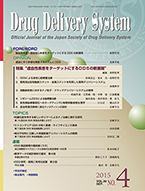Volume 30, Issue 4
New development of DDS targeting cerebral and cardiovascular ischemic diseases
Displaying 1-18 of 18 articles from this issue
- |<
- <
- 1
- >
- >|
[Feature articles] “New development of DDS targeting cerebral and cardiovascular ischemic diseases”
-
2015 Volume 30 Issue 4 Pages 273
Published: September 25, 2015
Released on J-STAGE: December 25, 2015
Download PDF (180K) -
2015 Volume 30 Issue 4 Pages 274
Published: September 25, 2015
Released on J-STAGE: December 25, 2015
Download PDF (177K) -
2015 Volume 30 Issue 4 Pages 276-285
Published: September 25, 2015
Released on J-STAGE: December 25, 2015
Download PDF (831K) -
2015 Volume 30 Issue 4 Pages 286-298
Published: September 25, 2015
Released on J-STAGE: December 25, 2015
Download PDF (1412K) -
2015 Volume 30 Issue 4 Pages 299-308
Published: September 25, 2015
Released on J-STAGE: December 25, 2015
Download PDF (1402K) -
2015 Volume 30 Issue 4 Pages 309-316
Published: September 25, 2015
Released on J-STAGE: December 25, 2015
Download PDF (3477K) -
2015 Volume 30 Issue 4 Pages 317-326
Published: September 25, 2015
Released on J-STAGE: December 25, 2015
Download PDF (1134K) -
2015 Volume 30 Issue 4 Pages 327-335
Published: September 25, 2015
Released on J-STAGE: December 25, 2015
Download PDF (1482K)
TOPICS
-
2015 Volume 30 Issue 4 Pages 336-347
Published: September 25, 2015
Released on J-STAGE: December 25, 2015
Download PDF (2362K) -
2015 Volume 30 Issue 4 Pages 348-362
Published: September 25, 2015
Released on J-STAGE: December 25, 2015
Download PDF (2141K) -
2015 Volume 30 Issue 4 Pages 363-370
Published: September 25, 2015
Released on J-STAGE: December 25, 2015
Download PDF (998K)
[Serial] Front line of DDS development in pharmaceutical industries
-
2015 Volume 30 Issue 4 Pages 371-376
Published: 2015
Released on J-STAGE: December 25, 2015
Download PDF (1077K)
[Serial] Fundamentals of statistical analysis in biomedical research
-
2015 Volume 30 Issue 4 Pages 377-388
Published: September 25, 2015
Released on J-STAGE: December 25, 2015
Download PDF (1272K)
[Serial] Reviews on useful reagents for DDS research and development
-
2015 Volume 30 Issue 4 Pages 390-392
Published: September 25, 2015
Released on J-STAGE: December 25, 2015
Download PDF (278K)
Meeting Reports
-
2015 Volume 30 Issue 4 Pages 394-395
Published: September 25, 2015
Released on J-STAGE: December 25, 2015
Download PDF (713K) -
2015 Volume 30 Issue 4 Pages 396-397
Published: September 25, 2015
Released on J-STAGE: December 25, 2015
Download PDF (466K) -
2015 Volume 30 Issue 4 Pages 398-400
Published: September 25, 2015
Released on J-STAGE: December 25, 2015
Download PDF (1101K) -
2015 Volume 30 Issue 4 Pages 402-404
Published: September 25, 2015
Released on J-STAGE: December 25, 2015
Download PDF (273K)
- |<
- <
- 1
- >
- >|
